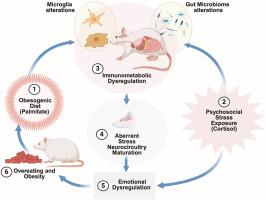Early-life obesogenic environment integrates immunometabolic and epigenetic signatures governing neuroinflammation
IF 3.7
Q2 IMMUNOLOGY
引用次数: 0
Abstract
Childhood overweight/obesity is associated with stress-related psychopathology, yet the pathways connecting childhood obesity to stress susceptibility are poorly understood. We employed a systems biology approach with 62 adolescent Lewis rats fed a Western-like high-saturated fat diet (WD, 41% kcal from fat) or a control diet (CD, 13% kcal from fat). A subset of rats underwent a 31-day model of predator exposures and social instability (PSS). Effects were assessed using behavioral tests, DTI (diffusion tensor imaging), NODDI (neurite orientation dispersion and density imaging), 16S rRNA gene sequencing for gut microbiome profiling, hippocampal microglia analysis, and targeted gene methylation. Parallel experiments on human microglia cells (HMC3) examined how palmitic acid influences cortisol-related inflammatory responses.
Rats exposed to WD and PSS exhibited deficits in sociability, increased fear/anxiety-like behaviors, food consumption, and body weight. WD/PSS altered hippocampal microstructure (subiculum, CA1, dentate gyrus), and microbiome analysis showed a reduced abundance of members of the phylum Firmicutes. WD/PSS synergistically promoted neuroinflammatory changes in hippocampal microglia, linked with microbiome shifts and altered Fkbp5 expression/methylation. In HMC3, palmitate disrupted cortisol responses, affecting morphology, phagocytic markers, and cytokine release, partially mediated by FKBP5.
This study identifies gene-environment interactions that influence microglia biology and may contribute to the connection between childhood obesity and stress-related psychopathology later in life.

生命早期的肥胖环境整合了免疫代谢和表观遗传特征,对神经炎症起着调节作用
儿童期超重/肥胖与压力相关的精神病理学有关,但人们对儿童期肥胖与压力易感性之间的联系途径却知之甚少。我们采用了一种系统生物学方法,对 62 只青少年 Lewis 大鼠喂食类似西方的高饱和脂肪饮食(WD,41% 千卡热量来自脂肪)或对照饮食(CD,13% 千卡热量来自脂肪)。其中一部分大鼠接受了为期 31 天的捕食者暴露和社会不稳定性(PSS)模型试验。通过行为测试、DTI(弥散张量成像)、NODDI(神经元定向弥散和密度成像)、16S rRNA 基因测序(用于肠道微生物组分析)、海马小胶质细胞分析和靶向基因甲基化来评估其影响。在人类小胶质细胞(HMC3)上进行的平行实验研究了棕榈酸如何影响与皮质醇相关的炎症反应。暴露于 WD 和 PSS 的大鼠表现出社交障碍、恐惧/焦虑样行为增加、食量和体重增加。WD/PSS改变了海马的微观结构(子网、CA1、齿状回),微生物组分析表明,固着菌门成员的丰度降低。WD/PSS 协同促进了海马小胶质细胞的神经炎症变化,这与微生物组的变化和 Fkbp5 表达/甲基化的改变有关。在 HMC3 中,棕榈酸酯会扰乱皮质醇反应,影响形态、吞噬标记物和细胞因子释放,部分由 FKBP5 介导。这项研究确定了影响小胶质细胞生物学的基因-环境相互作用,并可能有助于研究儿童肥胖与日后生活中与压力相关的精神病理学之间的联系。
本文章由计算机程序翻译,如有差异,请以英文原文为准。
求助全文
约1分钟内获得全文
求助全文
来源期刊

Brain, behavior, & immunity - health
Biological Psychiatry, Behavioral Neuroscience
CiteScore
8.50
自引率
0.00%
发文量
0
审稿时长
97 days
 求助内容:
求助内容: 应助结果提醒方式:
应助结果提醒方式:


